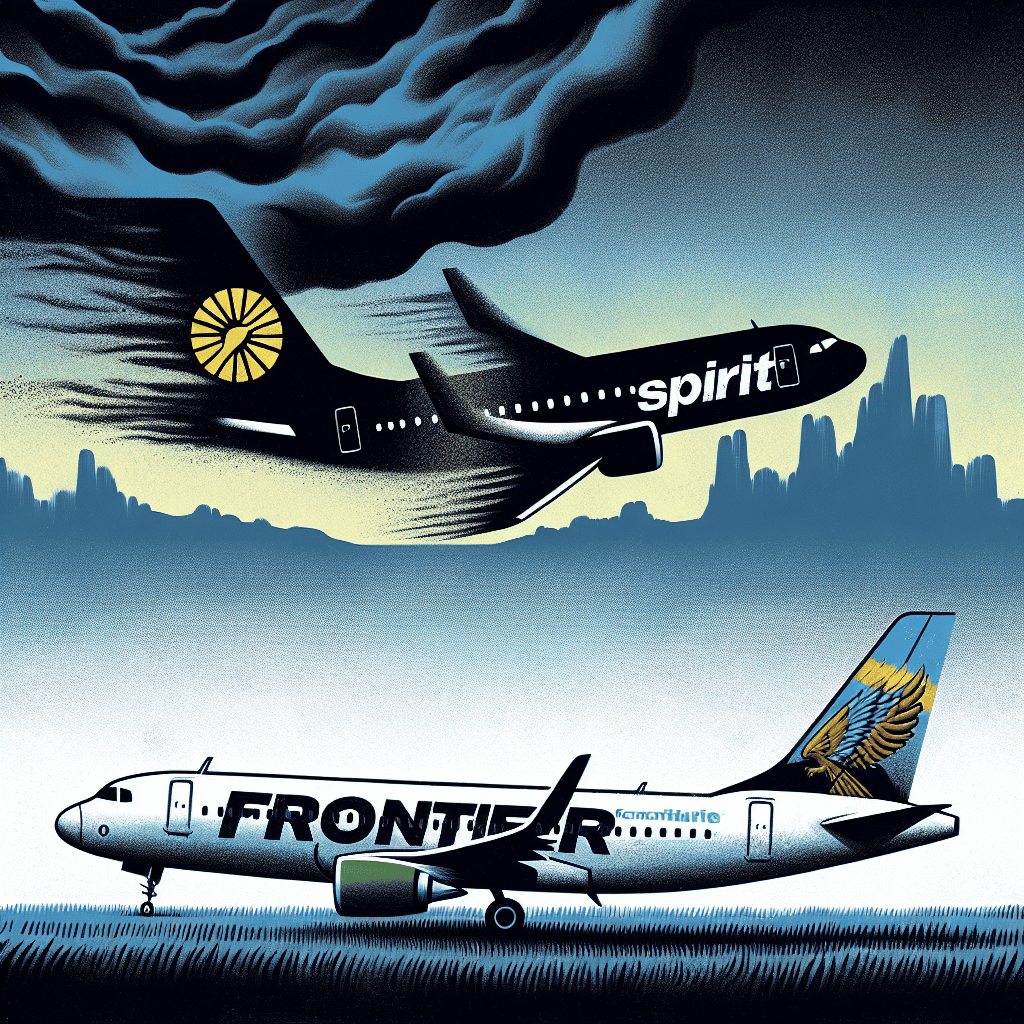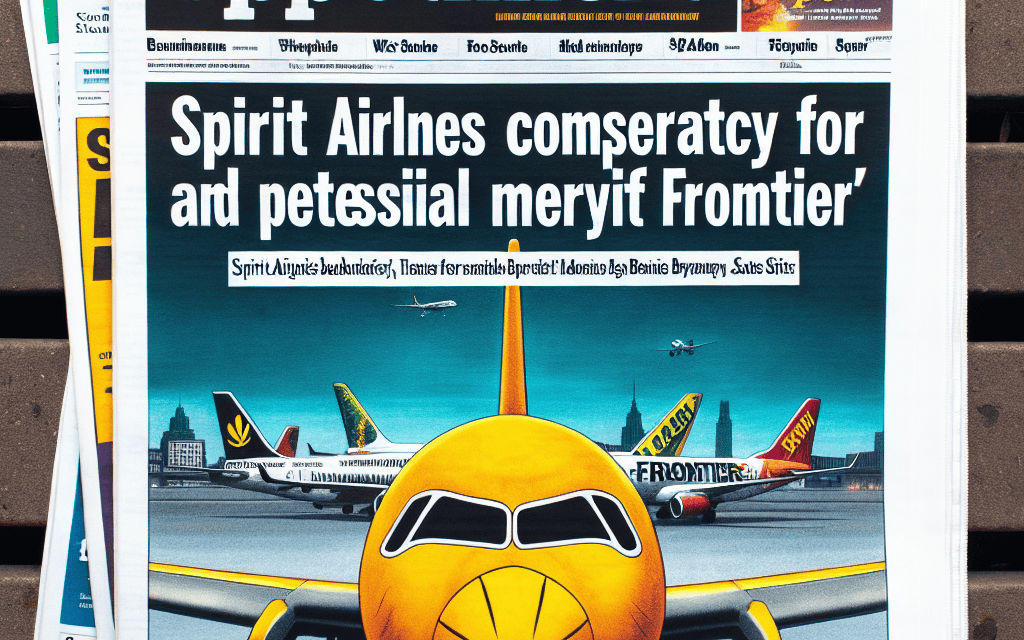“Navigating Turbulence: Spirit Airlines Eyes Bankruptcy for a Smoother Merger with Frontier”
Introduction
Spirit Airlines is reportedly contemplating filing for bankruptcy as a strategic move to facilitate its merger with Frontier Airlines. This potential decision comes amid ongoing financial challenges and competitive pressures within the airline industry. By pursuing bankruptcy, Spirit aims to restructure its debts and streamline operations, thereby smoothing the path for a successful merger with Frontier. The merger is anticipated to create a more robust low-cost carrier, enhancing competitiveness against larger airlines. However, the bankruptcy consideration underscores the complexities and financial hurdles involved in consolidating two major players in the budget airline sector.
Impact Of Spirit Airlines’ Bankruptcy On The Aviation Industry
The potential bankruptcy of Spirit Airlines as a strategic move to facilitate its merger with Frontier Airlines has sent ripples through the aviation industry, raising questions about the broader implications for the sector. This development, while primarily a corporate maneuver, could have far-reaching consequences for various stakeholders, including passengers, employees, competitors, and the overall market dynamics. As Spirit Airlines contemplates this drastic step, it is essential to examine the potential impacts on the aviation landscape.
Firstly, the merger between Spirit and Frontier, two of the largest ultra-low-cost carriers in the United States, aims to create a formidable competitor in the budget airline segment. By potentially filing for bankruptcy, Spirit Airlines seeks to streamline its operations, reduce debt, and address any financial liabilities that could hinder the merger process. This move could lead to a more robust and financially stable entity, capable of offering competitive fares and expanding its market share. However, the bankruptcy process itself may introduce uncertainties, particularly concerning the continuity of services and the retention of customer loyalty.
Moreover, the impact on passengers cannot be overlooked. Spirit Airlines has built its reputation on providing affordable travel options, often at the expense of additional amenities. A bankruptcy filing could lead to changes in service offerings, route adjustments, or even temporary disruptions. While the merger promises enhanced operational efficiencies and potentially improved customer experiences, the transition period may pose challenges for travelers accustomed to Spirit’s existing model. It remains to be seen how the new entity will balance cost-effectiveness with service quality, a critical factor in maintaining customer satisfaction and loyalty.
In addition to passenger considerations, the potential bankruptcy and subsequent merger could have significant implications for employees. Spirit Airlines’ workforce may face uncertainties regarding job security, changes in employment terms, or even potential layoffs as the company restructures. However, the merger could also present opportunities for growth and career advancement within a larger, more competitive airline. The outcome will largely depend on how effectively the merged entity manages its human resources and integrates the two corporate cultures.
Furthermore, the competitive landscape of the aviation industry could be reshaped by this merger. The combined entity of Spirit and Frontier would likely exert increased pressure on other low-cost carriers, prompting them to reassess their strategies and pricing models. This heightened competition could ultimately benefit consumers by driving down fares and encouraging innovation in service offerings. However, it may also lead to market consolidation, reducing the number of players in the budget airline segment and potentially limiting choices for travelers.
Lastly, the potential bankruptcy of Spirit Airlines underscores the broader challenges facing the aviation industry, particularly in the wake of the COVID-19 pandemic. Airlines worldwide have grappled with fluctuating demand, rising operational costs, and evolving consumer preferences. The Spirit-Frontier merger, facilitated by a strategic bankruptcy, highlights the need for adaptability and resilience in an industry characterized by volatility. As airlines navigate these complexities, strategic alliances and financial restructuring may become increasingly common as carriers seek to secure their positions in a rapidly changing market.
In conclusion, Spirit Airlines’ consideration of bankruptcy as a means to facilitate its merger with Frontier Airlines presents a multifaceted scenario with implications for passengers, employees, competitors, and the aviation industry as a whole. While the merger holds the promise of creating a stronger budget airline, the path to achieving this goal is fraught with challenges and uncertainties. As the situation unfolds, stakeholders will be closely monitoring the developments, eager to understand how this strategic move will ultimately shape the future of air travel.
Pros And Cons Of Spirit Airlines Merging With Frontier
The potential merger between Spirit Airlines and Frontier Airlines has sparked considerable discussion within the aviation industry, particularly as Spirit Airlines contemplates bankruptcy as a strategic move to facilitate this union. This merger, if realized, could significantly reshape the landscape of low-cost air travel in the United States. However, it is essential to weigh the pros and cons of such a merger to understand its implications fully.
On the positive side, a merger between Spirit and Frontier could create a formidable low-cost carrier, potentially offering more competitive pricing and expanded route options for consumers. By combining their resources, the two airlines could achieve economies of scale, leading to reduced operational costs. This reduction could, in turn, be passed on to passengers in the form of lower fares, making air travel more accessible to a broader demographic. Additionally, the merger could enhance the airlines’ bargaining power with suppliers and airports, further driving down costs and improving service offerings.
Moreover, the merger could lead to an expanded network, providing passengers with more destinations and flight options. This expansion could be particularly beneficial for travelers in underserved markets, where increased competition might lead to better service and more choices. The combined airline could also streamline operations, potentially improving efficiency and reliability, which are critical factors for passengers when choosing an airline.
However, there are also potential drawbacks to consider. One significant concern is the possibility of reduced competition in the low-cost carrier market. With Spirit and Frontier merging, there would be one less competitor, which could lead to higher prices in the long run if the new entity decides to capitalize on its increased market share. This reduction in competition might also stifle innovation, as fewer players in the market could lead to less incentive to improve services and offerings.
Furthermore, the integration process of merging two airlines can be fraught with challenges. Differences in corporate culture, operational systems, and customer service philosophies could lead to disruptions and inefficiencies during the transition period. These challenges might result in a temporary decline in service quality, affecting customer satisfaction and loyalty. Additionally, the merger could lead to job redundancies, as overlapping roles and functions are consolidated, potentially impacting employees and their families.
Another critical aspect to consider is the regulatory scrutiny that such a merger would likely face. Antitrust authorities would closely examine the merger to ensure it does not create a monopoly or significantly reduce competition in the market. This scrutiny could lead to delays or even the imposition of conditions that might affect the merger’s potential benefits.
In conclusion, while the merger between Spirit Airlines and Frontier Airlines presents several potential advantages, such as cost savings, expanded networks, and improved service offerings, it also poses significant challenges and risks. The potential reduction in competition, integration difficulties, and regulatory hurdles are critical factors that must be carefully considered. As Spirit Airlines contemplates bankruptcy as a means to facilitate this merger, stakeholders must weigh these pros and cons to determine the best path forward for both airlines and their customers. Ultimately, the success of this merger will depend on how effectively the two airlines can navigate these challenges while capitalizing on the opportunities presented by their union.
How Bankruptcy Could Affect Spirit Airlines’ Customers
Spirit Airlines’ potential bankruptcy filing as a strategic move to facilitate its merger with Frontier Airlines has raised numerous questions about the implications for its customers. While bankruptcy often conjures images of financial distress and uncertainty, it is essential to understand how this legal process might impact those who rely on Spirit Airlines for their travel needs. By examining the potential effects on flight operations, ticket prices, and customer service, we can gain a clearer picture of what Spirit Airlines’ customers might expect during this transitional period.
To begin with, it is important to note that a bankruptcy filing does not necessarily mean that Spirit Airlines will cease operations. In fact, many companies use bankruptcy as a tool to restructure their debts and streamline operations while continuing to serve their customers. For Spirit Airlines, this could mean maintaining its flight schedule and honoring existing reservations, thereby minimizing disruptions for travelers. However, customers should remain vigilant and stay informed about any announcements from the airline regarding changes to flight schedules or policies.
Moreover, the merger with Frontier Airlines could lead to a reevaluation of routes and services offered by the combined entity. While this might result in some route adjustments, it could also present opportunities for expanded service options and improved connectivity for passengers. Customers may benefit from a broader network of destinations and potentially enhanced service offerings as the two airlines integrate their operations. Nevertheless, it is crucial for travelers to monitor any updates from Spirit Airlines regarding changes to their preferred routes or services.
In terms of ticket prices, the merger could have both positive and negative effects. On one hand, the consolidation of Spirit and Frontier could lead to increased operational efficiencies, potentially resulting in cost savings that might be passed on to customers in the form of lower fares. On the other hand, reduced competition in certain markets could lead to higher prices. It is essential for customers to compare prices and explore alternative options to ensure they are getting the best value for their travel needs.
Customer service is another area that may experience changes as a result of the bankruptcy and merger. Spirit Airlines has historically been known for its no-frills approach, focusing on low-cost travel with limited amenities. The merger with Frontier could lead to a reevaluation of customer service policies and practices, potentially resulting in improvements or adjustments to better align with the combined airline’s strategic goals. Customers should be prepared for possible changes in service standards and policies, and they may need to adjust their expectations accordingly.
Furthermore, loyalty programs and frequent flyer benefits could also be affected by the merger. Spirit Airlines’ Free Spirit program and Frontier’s Frontier Miles program may undergo changes as the two airlines integrate their operations. Customers should stay informed about any updates to these programs and consider how changes might impact their travel plans and benefits.
In conclusion, while Spirit Airlines’ potential bankruptcy filing as part of its merger with Frontier Airlines may raise concerns for customers, it is important to recognize that this process can also present opportunities for positive change. By staying informed and proactive, customers can navigate this transitional period with greater confidence and continue to enjoy the benefits of affordable air travel. As the situation evolves, Spirit Airlines’ customers should remain attentive to announcements and updates from the airline to ensure a smooth travel experience.
The Financial Implications Of A Spirit And Frontier Merger

The potential merger between Spirit Airlines and Frontier Airlines has been a topic of considerable interest within the aviation industry, particularly due to the financial implications it presents. As Spirit Airlines contemplates filing for bankruptcy to facilitate this merger, stakeholders are keenly observing the potential outcomes and impacts on the market. The merger, if successful, could create a formidable low-cost carrier in the United States, potentially reshaping the competitive landscape of the airline industry. However, the financial intricacies involved in such a merger are complex and warrant a closer examination.
Filing for bankruptcy, while often perceived negatively, can be a strategic move for Spirit Airlines. By doing so, Spirit could potentially restructure its debts and obligations, thereby streamlining its financial operations. This restructuring could make the merger with Frontier more feasible by aligning the financial interests of both entities. Moreover, bankruptcy could provide Spirit with the opportunity to renegotiate contracts and leases, potentially leading to cost savings that would benefit the merged entity. However, this approach is not without its risks. Bankruptcy could lead to a loss of consumer confidence, which might affect ticket sales and overall brand perception.
On the other hand, Frontier Airlines stands to gain significantly from this merger. By combining forces with Spirit, Frontier could expand its market share and enhance its operational efficiencies. The merger could lead to a more extensive route network, offering passengers more options and potentially lower fares due to increased competition. Additionally, the combined entity could leverage economies of scale, reducing operational costs and increasing profitability. However, integrating two distinct corporate cultures and operational systems presents its own set of challenges, which could impact the smooth execution of the merger.
From a financial perspective, the merger could also attract scrutiny from regulatory bodies concerned with antitrust issues. The consolidation of two major low-cost carriers could potentially reduce competition in certain markets, leading to higher prices for consumers. Therefore, Spirit and Frontier would need to present a compelling case to regulators, demonstrating that the merger would ultimately benefit consumers through improved services and competitive pricing. This regulatory hurdle is a significant consideration in the financial planning of the merger.
Furthermore, the merger could have broader implications for the airline industry as a whole. Competitors may respond by adjusting their pricing strategies or seeking mergers of their own to maintain market position. This potential ripple effect underscores the importance of strategic financial planning and market analysis in the execution of the Spirit-Frontier merger.
In conclusion, while the potential merger between Spirit Airlines and Frontier Airlines presents numerous financial opportunities, it also involves significant risks and challenges. The decision for Spirit to consider bankruptcy as a means to facilitate the merger is a testament to the complexity of the financial landscape in which airlines operate. As the situation unfolds, stakeholders will be closely monitoring the financial strategies employed by both airlines to ensure a successful merger that benefits not only the companies involved but also the consumers they serve. The outcome of this merger could set a precedent for future consolidations within the airline industry, highlighting the intricate balance between financial strategy and market dynamics.
Regulatory Challenges In The Spirit-Frontier Merger
The potential merger between Spirit Airlines and Frontier Airlines has been a topic of considerable interest within the aviation industry, as it promises to reshape the competitive landscape of low-cost carriers in the United States. However, the path to this merger is fraught with regulatory challenges that could significantly impact its successful execution. One of the most pressing issues is Spirit Airlines’ consideration of filing for bankruptcy as a strategic maneuver to facilitate the merger process. This potential move underscores the complexities involved in navigating regulatory frameworks while attempting to consolidate two major players in the airline sector.
The merger between Spirit and Frontier is primarily driven by the desire to create a more formidable competitor against larger airlines, thereby offering consumers more choices and potentially lower fares. However, regulatory bodies, particularly the Department of Justice (DOJ) and the Department of Transportation (DOT), are tasked with ensuring that such mergers do not stifle competition or harm consumer interests. These agencies scrutinize mergers to prevent monopolistic practices and to maintain a healthy competitive environment. Consequently, Spirit and Frontier must demonstrate that their merger will not lead to reduced competition or increased prices for consumers.
In this context, Spirit Airlines’ consideration of bankruptcy emerges as a strategic option to address potential regulatory hurdles. By filing for bankruptcy, Spirit could potentially restructure its financial obligations, streamline operations, and present a more viable case for the merger. This approach might also alleviate some antitrust concerns by allowing Spirit to shed certain assets or routes that could otherwise be seen as anti-competitive. However, this strategy is not without its risks and complexities. Bankruptcy proceedings can be lengthy and unpredictable, potentially delaying the merger and creating uncertainty for stakeholders, including employees, customers, and investors.
Moreover, the regulatory landscape is further complicated by the current administration’s focus on antitrust enforcement. The Biden administration has signaled a more aggressive stance on scrutinizing mergers and acquisitions, particularly in industries where consumer choice and competition are at stake. This heightened scrutiny means that Spirit and Frontier must be prepared to make a compelling case that their merger will benefit consumers and not lead to a reduction in service quality or availability.
In addition to regulatory challenges, the merger faces potential opposition from other industry players who may view the consolidation as a threat to their market share. Larger airlines, in particular, may lobby against the merger, arguing that it could lead to unfair competitive advantages. This opposition could further complicate the regulatory approval process, requiring Spirit and Frontier to engage in extensive negotiations and possibly make concessions to gain approval.
Despite these challenges, the potential benefits of the merger are significant. A combined Spirit-Frontier entity could leverage economies of scale to reduce operational costs, expand route networks, and enhance service offerings. This could ultimately lead to more competitive pricing and improved options for consumers, aligning with the broader goals of fostering competition and innovation within the airline industry.
In conclusion, while the merger between Spirit Airlines and Frontier Airlines presents a promising opportunity to enhance competition in the low-cost carrier market, it is not without significant regulatory challenges. Spirit’s consideration of bankruptcy as a strategic tool highlights the complexities involved in navigating these challenges. As the process unfolds, the outcome will depend on the ability of both airlines to address regulatory concerns, engage with stakeholders, and demonstrate the merger’s potential benefits to consumers and the industry at large.
The Future Of Low-Cost Carriers Post-Spirit Bankruptcy
The potential bankruptcy of Spirit Airlines as a strategic move to facilitate its merger with Frontier Airlines has sparked considerable discussion about the future of low-cost carriers in the aviation industry. This development, while surprising to some, is a calculated maneuver aimed at streamlining the merger process and ensuring the long-term viability of the combined entity. As the aviation sector continues to recover from the disruptions caused by the COVID-19 pandemic, the implications of such a merger are significant, not only for the companies involved but also for the broader landscape of budget air travel.
Spirit Airlines, known for its ultra-low-cost business model, has long been a major player in the budget airline market. By offering no-frills service and a la carte pricing, Spirit has been able to maintain competitive fares, attracting cost-conscious travelers. However, the airline industry is notoriously volatile, and Spirit has faced its share of challenges, including fluctuating fuel prices, labor disputes, and increased competition. In this context, the proposed merger with Frontier Airlines represents an opportunity to consolidate resources, expand market reach, and enhance operational efficiencies.
Frontier Airlines, like Spirit, operates on a low-cost model, emphasizing affordability and efficiency. The merger of these two carriers promises to create a formidable competitor in the low-cost segment, potentially rivaling larger airlines in terms of market share. By combining their fleets, routes, and customer bases, Spirit and Frontier aim to achieve economies of scale that could lead to lower operating costs and, ultimately, more competitive pricing for consumers. This strategic alignment is particularly relevant as the industry seeks to rebound from the pandemic’s impact, which saw a dramatic decline in passenger numbers and revenue.
However, the path to a successful merger is fraught with challenges. One of the primary hurdles is regulatory approval, as antitrust authorities will closely scrutinize the deal to ensure it does not stifle competition or harm consumer interests. In this regard, Spirit’s consideration of bankruptcy is a tactical move designed to address potential regulatory concerns. By restructuring its financial obligations through bankruptcy, Spirit can present a more streamlined and financially stable profile, potentially easing the path to regulatory approval.
Moreover, the merger raises questions about the future of low-cost carriers and their role in the aviation ecosystem. As the industry evolves, budget airlines must adapt to changing consumer preferences, technological advancements, and environmental considerations. The Spirit-Frontier merger could serve as a catalyst for innovation within the sector, prompting other low-cost carriers to explore similar partnerships or adopt new business models to remain competitive.
In conclusion, the potential bankruptcy of Spirit Airlines as a means to facilitate its merger with Frontier Airlines is a strategic decision with far-reaching implications for the future of low-cost carriers. While the merger presents opportunities for growth and increased competitiveness, it also poses challenges that must be carefully navigated. As the aviation industry continues to recover and adapt to new realities, the outcome of this merger will likely influence the trajectory of budget air travel, shaping the experiences of travelers and the strategies of airlines for years to come.
Comparing Spirit Airlines’ Strategy With Other Airline Mergers
In the ever-evolving landscape of the airline industry, mergers and acquisitions have long been strategic maneuvers employed by companies to enhance their market position, streamline operations, and achieve synergies. Spirit Airlines’ recent contemplation of bankruptcy as a means to facilitate its merger with Frontier Airlines presents a unique case study in the realm of airline mergers. This strategy, while unconventional, highlights the complexities and challenges inherent in the consolidation of two major carriers. To better understand Spirit Airlines’ approach, it is instructive to compare it with other notable airline mergers and the strategies they employed.
Historically, airline mergers have been driven by the pursuit of increased market share, expanded route networks, and cost efficiencies. For instance, the merger between Delta Air Lines and Northwest Airlines in 2008 was primarily motivated by the desire to create a more competitive global airline. By combining their resources, Delta and Northwest were able to offer a more comprehensive network, thereby attracting a broader customer base. Similarly, the merger between United Airlines and Continental Airlines in 2010 was aimed at creating a more robust airline capable of competing on an international scale. These mergers were characterized by a focus on integration and the realization of operational synergies without resorting to bankruptcy proceedings.
In contrast, Spirit Airlines’ consideration of bankruptcy as a strategic tool to facilitate its merger with Frontier Airlines underscores a different approach. This tactic, while not unprecedented, is less common in the airline industry. Bankruptcy can provide a mechanism for restructuring debt and renegotiating contracts, potentially making the merged entity more financially viable. However, it also carries significant risks, including potential damage to brand reputation and customer confidence. Spirit’s strategy suggests a willingness to embrace these risks in pursuit of long-term benefits, such as a stronger competitive position and enhanced operational efficiencies.
Comparing Spirit’s approach with the American Airlines and US Airways merger in 2013 offers further insights. In that instance, American Airlines was already in bankruptcy when it merged with US Airways. The merger was seen as a lifeline for American, allowing it to emerge from bankruptcy as a more formidable competitor. The success of this merger was largely attributed to the careful management of the integration process and the ability to leverage the strengths of both airlines. Spirit’s potential use of bankruptcy as a preemptive measure, rather than a reactive one, sets it apart from the American-US Airways scenario.
Moreover, the proposed Spirit-Frontier merger raises questions about the regulatory landscape and antitrust considerations. In previous mergers, such as the Southwest Airlines and AirTran Airways merger in 2011, regulatory approval was contingent upon addressing concerns related to competition and consumer choice. Spirit and Frontier will likely face similar scrutiny, necessitating a well-crafted strategy to navigate these regulatory hurdles.
In conclusion, Spirit Airlines’ contemplation of bankruptcy to facilitate its merger with Frontier Airlines represents a distinctive approach within the airline industry. By examining this strategy in the context of other airline mergers, it becomes evident that while the objectives of increased market share and operational efficiencies remain consistent, the paths to achieving these goals can vary significantly. Spirit’s willingness to explore bankruptcy as a strategic tool highlights the complexities and challenges of airline mergers, offering valuable lessons for industry stakeholders and observers alike.
Q&A
1. **What is the main reason Spirit Airlines is considering bankruptcy?**
Spirit Airlines is considering bankruptcy to facilitate a merger with Frontier Airlines, potentially easing financial and regulatory hurdles.
2. **How would bankruptcy benefit the merger process with Frontier?**
Bankruptcy could allow Spirit to restructure its debts and contracts, making the merger with Frontier more financially viable and attractive.
3. **What are the potential challenges Spirit Airlines faces in merging with Frontier?**
Challenges include regulatory scrutiny, integration of operations and staff, and aligning business strategies and customer service models.
4. **How might bankruptcy impact Spirit Airlines’ operations?**
Bankruptcy could lead to operational restructuring, potential route reductions, and renegotiation of labor and supplier contracts.
5. **What are the implications for Spirit Airlines’ employees if bankruptcy is pursued?**
Employees might face uncertainty regarding job security, potential layoffs, or changes in employment terms as part of the restructuring process.
6. **How could Spirit Airlines’ customers be affected by the bankruptcy and merger?**
Customers might experience changes in flight schedules, loyalty programs, and service offerings, but could also benefit from potentially improved services post-merger.
7. **What are the strategic goals behind Spirit Airlines’ merger with Frontier?**
The strategic goals include creating a larger, more competitive low-cost carrier, expanding market reach, and achieving cost efficiencies through combined operations.
Conclusion
Spirit Airlines’ consideration of bankruptcy as a strategy to facilitate a merger with Frontier highlights the complex financial and strategic maneuvers companies may undertake to achieve consolidation in the competitive airline industry. By potentially using bankruptcy proceedings, Spirit could address its financial liabilities and streamline operations, making the merger more viable and attractive to stakeholders. This move could ultimately lead to a stronger combined entity, better positioned to compete with larger carriers, though it also involves significant risks and uncertainties, including regulatory scrutiny and the impact on employees and customers.





